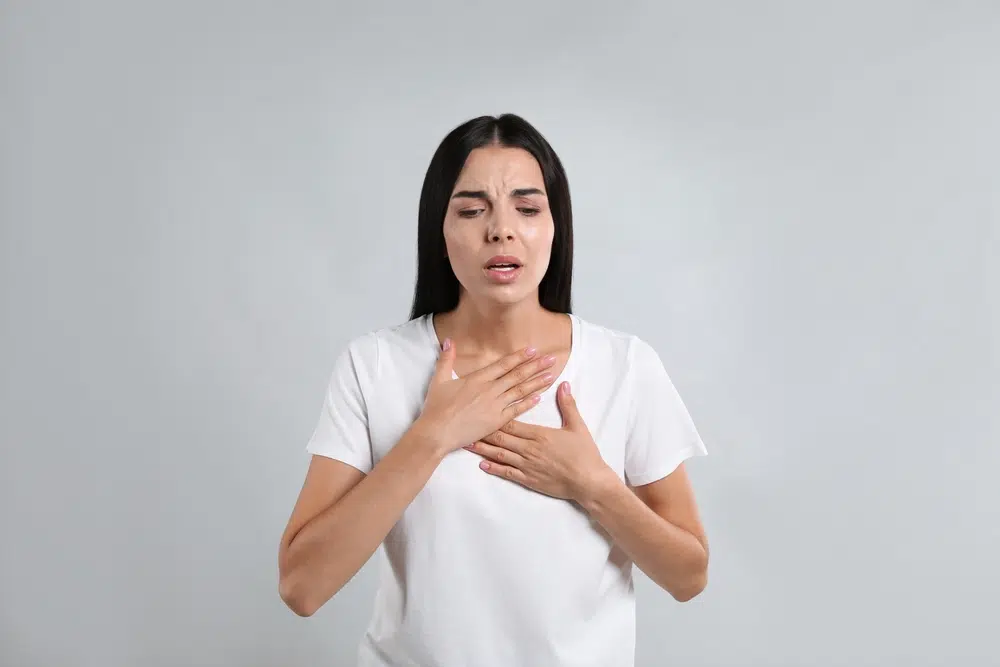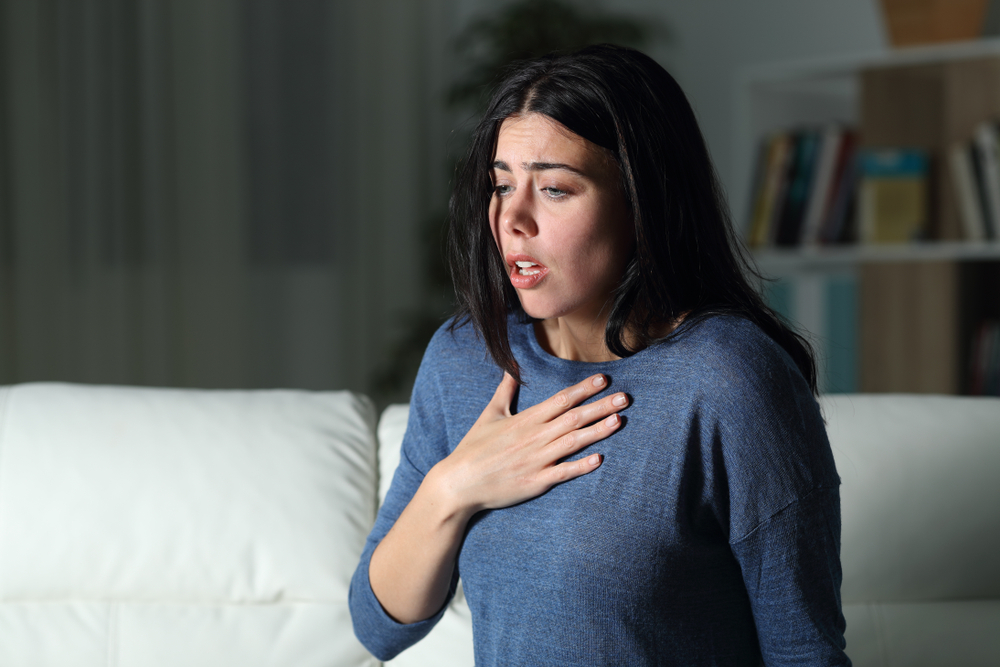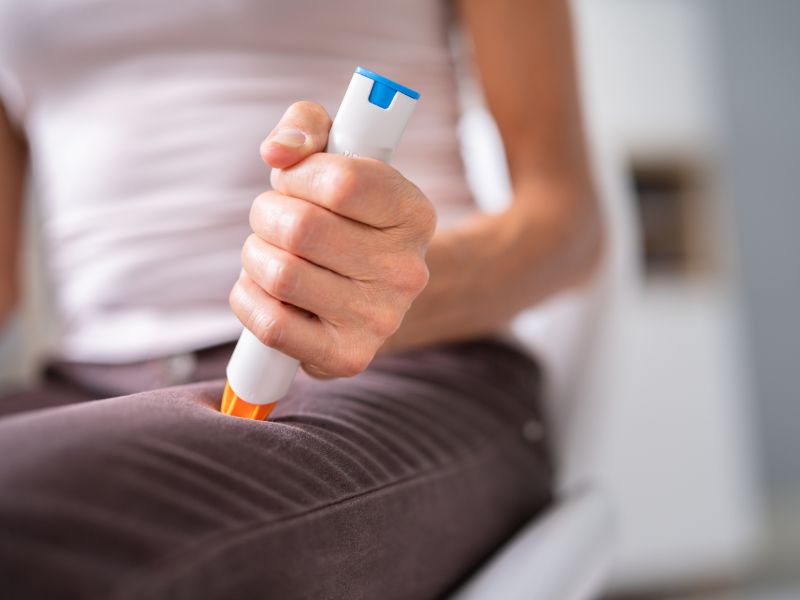Anaphylaxis is a severe and potentially life-threatening allergic reaction that requires immediate medical attention. It can be triggered by various substances, including certain foods, medications, insect venom, and latex. This medical emergency can occur as a result of food allergies, insect stings, or even idiopathic anaphylaxis, where the cause is unknown.
This article will help you understand the different stages of anaphylaxis, recognize its symptoms, and take appropriate action if you or someone you know experiences an anaphylactic reaction.

Managing Anaphylaxis at Every Stage – Snapshot Guide
| Stage | What to Do | Key Reminder | Risk Level |
|---|---|---|---|
| Stage 1: Mild Anaphylaxis | Monitor symptoms and remove the trigger. Keep epinephrine close. | Early signs can be deceptive — don’t ignore them. | Low, but may escalate |
| Stage 2: Moderate Anaphylaxis | Use epinephrine. Call 911. Keep the person calm and lying down. | Don’t wait — treat at the first sign of worsening. | Moderate to high |
| Stage 3: Severe Anaphylaxis | Ensure epinephrine was given. Watch breathing. Be ready for second dose. | This is a medical emergency — act fast. | High |
| Stage 4: Life-Threatening | Call 911. Start CPR if needed. Second epinephrine dose may be needed. | Every second counts — act immediately. | Critical |
Triggers and Causes of Anaphylaxis
Anaphylaxis is an extreme and rapid immune response to an allergen, which is a substance that triggers an allergic reaction. Common triggers of anaphylaxis include:
The 4 Anaphylaxis Stages
Stage 1: Mild Symptoms of Anaphylaxis
The first stage of anaphylaxis, also known as a mild allergic reaction, is characterized by mild symptoms that may not immediately indicate a severe anaphylactic reaction. Common symptoms include:
- Itching
- Skin redness or localized hives
- Runny or stuffy nose
- Sneezing or watery eyes
- Mild symptoms following insect stings, bites, or food allergens (e.g., tree nuts)
During this stage, an individual may experience symptoms similar to those of a less severe allergic reaction, such as contact dermatitis or an allergic reaction to dust mites. However, it’s crucial to stay alert — especially with a known allergen. Repeated exposure may increase risk for more serious reactions.
What to do: Monitor closely and consult a healthcare provider. Be prepared to act if symptoms escalate.
Stage 2: Moderate Symptoms of Anaphylaxis
At this stage, symptoms become more intense and widespread.
You may notice:
- Swelling of the face, lips, or tongue
- Persistent hives or rash
- Hoarseness or trouble swallowing
- Nausea, vomiting, or diarrhea
- Itchy or watery eyes, nasal congestion
What to do:
Seek medical attention immediately. Use an epinephrine autoinjector if available. Moderate symptoms can rapidly worsen without treatment.
Stage 3: Severe Symptoms of Anaphylaxis
Severe anaphylaxis is a medical emergency with serious complications.
Symptoms may include:
- Swelling of the airways (bronchospasm)
- Shortness of breath or wheezing
- Chest pain or tightness
- Weak or rapid pulse
- Lightheadedness or loss of consciousness
- Significant drop in blood pressure
What to do:
Administer epinephrine and call emergency services right away. Without prompt intervention, this stage can lead to irreversible harm.
Stage 4: Life-Threatening Symptoms of Anaphylaxis
This final stage involves full systemic failure and can result in anaphylactic shock or cardiac arrest.
Signs of life-threatening anaphylaxis:
- Extremely low blood pressure
- Weak or absent pulse
- Respiratory failure due to severe airway swelling
- Organ failure from poor blood flow
- Cardiac arrest
What to do:
Call 911 immediately. Administer epinephrine and start CPR if needed and trained. This is a critical, life-or-death emergency
Recognizing the Symptoms of Anaphylaxis
Anaphylaxis symptoms can appear within seconds to minutes of exposure to an allergen and can progress rapidly. Early recognition of these symptoms is crucial for timely intervention and treatment. Common symptoms of anaphylaxis include:
- Severe skin rashes, itching, and hives
- Swelling of the lips, tongue, or throat
- Shortness of breath, wheezing, or chest tightness
- Dizziness, lightheadedness, or fainting
- Stomach pain, bloating, vomiting, or diarrhea
- Uterine cramps in women
- A sense of impending doom or anxiety

Worried About Anaphylaxis? Check Your Face for Early Signs
Early identification of symptoms of anaphylaxis in the face is crucial, and it often presents with distinctive signs.
The most common anaphylaxis sign among these is swelling — including of the lips, tongue, and eyelids. This can occur rapidly, leading to significant discomfort and alarm. Accompanying this swelling are often skin reactions, like a red, itchy rash or hives, particularly noticeable on the face and neck. Such reactions are not only uncomfortable but also indicative of a broader, systemic allergic response.
In addition to physical changes, patients may experience a sense of warmth or flushing in the face, coupled with a feeling of throat tightness or difficulty swallowing. This can escalate to a sensation of a lump in the throat, a marker of severe allergic reaction. Immediate action is crucial, use an epinephrine auto-injector and seek urgent medical care.
Timely recognition and action are crucial for managing anaphylaxis and improving outcomes.
Contact Penn Medicine Becker ENT & Allergy for urgent care.
Anaphylaxis Emergency Action Plan
Having an anaphylaxis emergency action plan in place is essential for individuals at risk of severe allergic reactions. This plan should include the following steps:
- Recognize the symptoms of anaphylaxis and assess their severity.
- Administer an epinephrine auto-injector (e.g., EpiPen) as soon as possible if severe symptoms are present. Epinephrine is the first-line treatment for anaphylaxis and can be life-saving.
- Call 911 or seek emergency medical care immediately, even if symptoms appear to improve after administering epinephrine.
- If trained to do so, perform CPR if the person loses consciousness or their pulse becomes weak or absent.
- Notify emergency medical personnel of the person’s history of anaphylaxis and any known allergens.

Preventing Future Anaphylactic Reactions
To prevent future anaphylactic reactions, it is crucial to identify and avoid known allergens that can trigger severe allergies or severe anaphylaxis. This involves working closely with a healthcare provider, allergy specialist, or immunologist to determine specific allergens and develop a personalized treatment plan. Key strategies for prevention include:
- Carrying an epinephrine autoinjector at all times, as a single dose can be life-saving in the event of an allergic emergency. It is essential to know how to use the autoinjector properly, and to administer it into the anterolateral thigh or mid-outer thigh during anaphylaxis symptoms.
- Wearing medical alert bracelets or carrying a card that identifies an individual’s allergies, history of anaphylaxis, and risk for anaphylaxis.
- Educating family, friends, and coworkers about an individual’s allergies, symptoms of anaphylaxis, and the importance of prompt treatment in the event of an anaphylactic emergency.
- Regularly reviewing and updating the anaphylaxis emergency action plan, which should include the recognition of symptoms, the administration of an epinephrine autoinjector, seeking emergency medical attention, and notifying medical services of the individual’s history and risk factors.
- Avoiding common triggers, such as allergenic foods, stinging insects like yellow jackets, and allergens that can cause respiratory symptoms or a drop in blood pressure.
By taking these preventive measures, individuals with a history of severe allergies or anaphylaxis can reduce their risk of future reactions, including biphasic anaphylaxis, where a second reaction occurs hours after the initial reaction. Early intervention, treatment options, and management of anaphylaxis are critical for preventing fatal anaphylaxis and ensuring the best possible outcome for those experiencing anaphylactic reactions.
Pediatric Anaphylaxis: Special Considerations
Anaphylaxis can be particularly challenging in children and adolescents due to their unique physiological and psychological needs.
- Symptom Recognition in Children: Young children may not articulate their symptoms effectively. Educating parents and caregivers on recognizing non-verbal cues like unusual clinginess or agitation is crucial.
- Age-Appropriate Treatment: Dosages of emergency medications like epinephrine vary with age and weight. Highlighting the importance of pediatric-specific treatment plans is essential.
- School Management: Strategies for managing anaphylaxis in school settings, including training school staff and peers about anaphylaxis recognition and response, and the importance of having individualized action plans.
- Emotional Support: Addressing the psychological impact of living with severe allergies in children, including anxiety and social challenges, and recommending support systems and resources.
- Dietary Management: Guidance for parents on navigating food allergies, safe food practices, and dietary alternatives for children with food-triggered anaphylaxis.

Dietary and Lifestyle Advice for Managing Food-Related Anaphylaxis
Living with food allergies requires continuous vigilance. Here are some strategies patients should follow regarding their diet:
- Deep Dive into Food Labels: Beyond recognizing obvious allergens, understand terms that might indicate hidden allergens. Watch for phrases like “may contain” or “manufactured in a facility that also processes.”
- Navigating Restaurants Safely: Research restaurants in advance and choose those with good reviews for allergy safety. Discuss your allergies with the chef, if possible, and always double-check your order.
- Minimizing Cross-Contamination at Home: Create an ‘allergen-free zone’ in your kitchen. Implement strict cleaning protocols for surfaces and utensils to prevent accidental exposure.
- Maintaining Nutritional Balance: Collaborate with a nutrition expert to plan a diet that compensates for excluded foods, ensuring you get all necessary vitamins and minerals.
- Emergency Plan Enhancement: Regularly review and update your emergency plan. Ensure family, friends, and co-workers are aware of how to assist in case of an allergic reaction.

